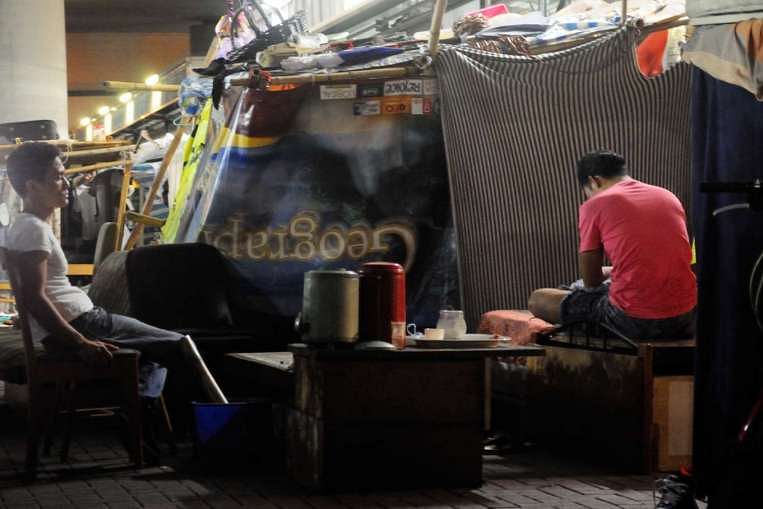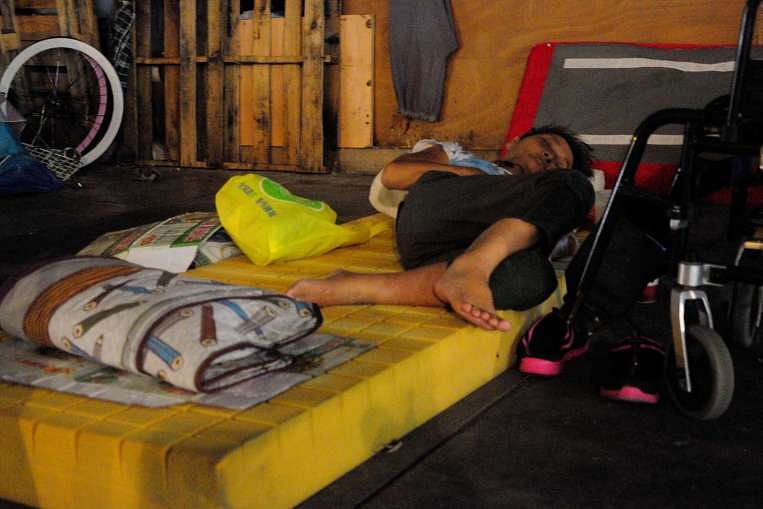This is what the hard ground beneath Hong Kong's social safety net looks like.
It is the stone bench in parks and under noisy flyovers.
It is the dusty floor of the Cultural Centre in Tsim Sha Tsui, a cardboard sheet in the shadows of the grand Peninsula Hotel.
It is the plastic chair of McDonald's restaurants.
It was at the latter that a middle- aged woman was found dead earlier this month, slumped over a table. For seven hours, staff and customers at the outlet in Ping Shek Estate, Kowloon Bay, swirled around her body, clearing trays and eating burgers, before someone called the police.
It is believed that the unidentified woman was homeless and part of a wave of some 60 McRefugees who make their beds in the fast- food giant's eateries. Since opening 24-hour outlets in Hong Kong a decade ago, McDonald's has become a refuge for some of the city's estimated 1,200 homeless.
The situation in Hong Kong, which has a population of 7.2 million, is comparable to that in some other developed cities in the region. Tokyo, with 13.4 million people, has some 5,000 homeless people. There are no publicly available figures for Singapore; just that between 2011 and 2013, the Ministry of Social and Family Development helped 565 individuals and 404 families among the population of 5.5 million people.
But the picture in Hong Kong is particularly visible and bleak, especially when juxtaposed against the city's ostentatious affluence.
For one, the number of homeless people is rising. Official statistics from the Social Welfare Department (SWD) indicate that there were 853 "registered street sleepers" as at end-August. This is up from 342 eight years ago, says Mr Ng Wai Tung of the Society for Community Organisation (Soco), a non-profit organisation that helps the needy.

Another disturbing trend is that Hong Kong's homeless are not just the elderly and ill. The Straits Times visited various spots where they congregate and met people ranging in age from their 30s to 70s. Although many work, they say they still cannot afford homes. Outside the Cultural Centre in Kowloon, for instance, Mr Lee Sai Wing, 36, a part-time croupier in Macau, and his girlfriend, Ms Kuit Choi Ping, 19, share a straw mat because they cannot pay for a flat, they say.
The proportion of the homeless aged below 49 rose from about one-third, or 32 per cent, in 2007, to almost half, or 45 per cent, in 2013, according to Soco.
The most obvious reason is a housing crisis. A raft of policies after the 2003 Sars outbreak - a halt to building subsidised public housing and abolition of rent-control measures - plus other factors like near-zero interest rates have led to spiralling home prices and years of waiting for public units.
Even so-called bed spaces - bunks the size of coffins in depressingly filthy tenement buildings - have seen their rents swell to between HK$1,800 and HK$2,400 (between S$325 and S$433) from HK$1,200 in 2007.
-
One in five residents lives in poverty: Report
One in five Hong Kongers lives in poverty.
A new annual report by the government shows that more than 1.3 million in a population of 7.2 million were below the city's poverty line last year.
The poverty line is set at half the median household income. Last year, this translated into HK$3,500 (S$630) for one-person households; HK$8,500 for two-person households; and HK$16,400 for four-person households.
But after factoring in cash handouts, the number of poor people fell to 960,000 and the poverty rate dipped to 14.3 per cent - the lowest in the past six years.
The fall could also be related to the establishment of the poverty line in Hong Kong in 2013.
"Updating the poverty line on a yearly basis helps keep (us) abreast of the poverty situation, assess the effectiveness of poverty alleviation policies and guide future policy formulation," the government said.
The latest statistics were released over the weekend during a summit to discuss Hong Kong's poor.
In particular, the situation of the elderly is dire, said the participants.
The number of poor people among those aged 60 and above increased by 44,000, reaching 294,000 last year.
It will be "an uphill battle" tackling this challenge because of Hong Kong's fast-ageing society, said Chief Secretary Carrie Lam.
The SWD tells The Straits Times it has measures in place to help the dispossessed. It funds NGOs in providing five single-person hostels and two emergency shelters, with a total of 202 spaces. Soco also gets about HK$1 million a year to help people find jobs and meet their short-term needs, such as buying uniforms or getting licences.
But such measures are inadequate, says Mr Ng. While the long- term solution is to find people work and affordable housing, Hong Kong should emulate cities like New York, where medium-term homeless shelters of three to seven years are offered, he says.
In Hong Kong, people can move into free shelters for up to only three months - and that sometimes comes at a cost. Many of the homeless resist the temporary help, fearing they will lose their spot on the streets once they leave, Mr Ng explains. In fee-paying hostels, they can stay for up to six months.
At Sham Shui Po in Kowloon, a sports car revs past a huddle of units, built of pallets and reeking of urine, under a flyover. There are about 100 occupants. Some take drugs. Many smoke.
Former waiter Chou Chung Tai, 76, and a friend managed to get a public rental flat but its toilet doorway was too narrow to let his wheelchair-bound friend pass through. "So we're back here again," he says with a shrug.

Soaring condominiums - with units costing about HK$8 million - overlook a public park where men bed down on benches and in pavilions. Mr Hoi Ming Chan, 44, who earns HK$10,000 a month as a salesman, struggles to keep his emotions in check as he tells of how he "used to be a clean freak" in his former life. After a divorce and a period of joblessness that depleted his savings, he now washes himself in public toilets.
Over in Admiralty, Hong Kong island's business district, a clutch of furniture - a clothes rack, rickety chairs - marks out the homeless occupants' territory under a bridge next to skyscrapers and the city's police headquarters.
All this makes for simmering tensions. Residents say it is "not fair" that they had paid so much for their property while the homeless stay "for free", recounts Mr Ng.
This means that the authorities are sometimes forced to act, in ways that seem unkind. A pavilion had its canopy removed. Another had its ground paved over with foot reflexology stones. Football fields are now locked.
Still, after a while, many Hong Kongers have also learnt to look the other way. Some lament the desensitised nature of society: How is it that a woman could have died in a crowded McDonald's eatery without anyone noticing?
But the vagrants are grateful that the fast-food chain's staff and patrons generally leave them alone, sometimes to nurse a cup of water for an entire night.
Sleeping indoors is safer for women, says a 43-year-old who does not want to be named. And she gets to eat leftovers, she adds.
Odd-job worker Chung Chi Man, 42, tells of a community of eight to 10 regulars where "if one of us get sick, we will help to buy medicine".

He pauses. He knows that such words notwithstanding, he may meet the same fate as the unknown woman who died alone at another McDonald's outlet.
"I may die like this too. But I have no choice. I have to resign myself to whatever life I have now."






